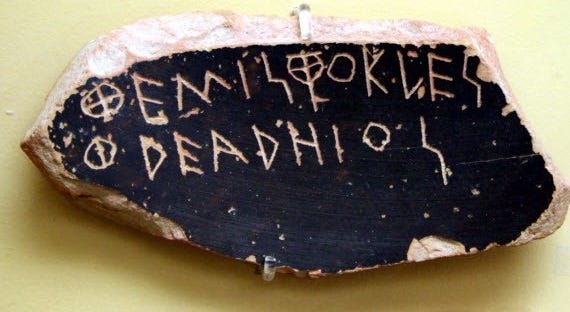Note: a Google Doc version is available for paid subscribers at the end of the worksheet, if you wish to add it to your Google Drive, have a pdf version, or print this out.
Introduction to Accentuation
Every Greek word has one and only one accent—exceptions exist where some words have no accents or will possess two, but we will discuss this in more detail later. That said, the accent will appear on one of the final three syllables of the word. There are three types of accents:
Acute: ά
Grave: ὰ
Circumflex: ᾶ
The rules of accentuation in Greek are rather complicated, and these will be explained slowly so that committing them to memory might be easier.
Syllabification
Simply, the number of syllables in a word is equivalent to the number of vowels and diphthongs. The Greek vowels are:
α, ε, η, ι, ο, υ, ω
Diphthongs, digraphs, and vowels with an iota subscript are a combination of two vowels, which generate one speech sound. These include
αυ, ευ, αι, οι, ηυ, υι; ου, ει; ᾳ, ῃ, ῳ1
If you see a word with two vowels in a row, it commonly counts as a diphthong/digraph, but it will only be one if it is included in the above list.
Some words will have a diacritical mark, ¨, e.g., νηΐ, which signifies that the vowels should be pronounced separately.
Syllabification: νη-ΐ
So, it bears repeating, just because two vowels reside next to one another, that does not constitute a diphthong, e.g., µῑµέοµαι.
Syllabification: µῑ-µέ-ο-µαι.
The first vowel cluster, εο, is not a diphthong or digraph, but the final is, αι.
If you see three vowels in a row, then it commonly counts as two syllables, i.e., a diphthong and a single vowel, e.g., σεαυτοῦ.
Syllabification: σε-αυ-τοῦ
Remember: in order to count the syllables, one must count the number of vowels and diphthongs/digraphs. It is crucial to recognize that a vowel or diphthong/digraph is not required to have an accompanying consonant, and that is why we count vowels.
Exercises
In the following Greek words, write out the vowels and diphthongs/digraphs, separating them with commas. Then, provide the number of syllables for each word and the syllabification.
If you wish to learn more about Greek and the New Testament, would you kindly subscribe?
For paid subscribers, if you wish to have access to the Google Doc, click the link below:
Keep reading with a 7-day free trial
Subscribe to Kurios About The New Testament to keep reading this post and get 7 days of free access to the full post archives.






